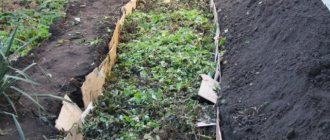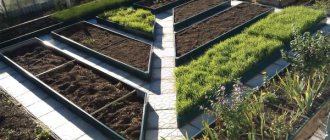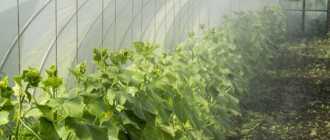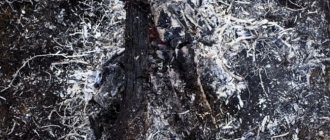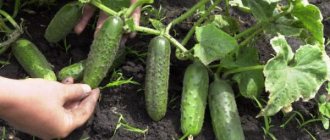When is it better to make warm beds: in spring or autumn?
Many will be surprised, but it is possible to get an early harvest of cucumbers without a greenhouse. For this purpose, warm beds are used. They work using thermal energy, which is generated as a result of complex physical and biochemical processes. This is a natural heating pad that helps plants develop faster and survive temperature changes. They are made from grass and organic fertilizers. Plus, decaying organic matter forms nutrients. We discussed the general rules for creating warm beds in this article.
Fertilizers begin to rot, release heat, and a reaction occurs - exothermic, in which aerobic and anaerobic bacteria participate. In the early stages, the temperature does not rise much, but every day it grows higher and higher.
You can prepare structures both in spring and autumn. To form beds in the fall, you have more plant material to fill the bed, which will be much fresher than in the spring. This includes any garden waste: leaves, branches, sawdust, twigs, stems, fruits, etc. In addition, in the fall there is more time for harvesting material and the temperature is suitable and the humidity is high. You can start cooking after harvesting; there is no need to rush anywhere. By spring, the soil will be sufficiently fertilized, all plant components will have time to rot and turn into compost. A good warm bed can last from 3-4 years to 7-8 years.
Spring option
It is not always possible to prepare an organic “pie” in the fall. This can be done in the spring, before planting begins. A warm bed for cucumbers will be slightly different, since the time to process its contents is reduced from 4 - 5 months to 3 weeks. In addition, there is much less plant material in the spring if gardeners do not have pre-prepared compost or manure in stock.
Suitable:
- onion peels, potato peelings and tubers, eggshells, banana peels, rotten apples, and so on;
- early green manure – mustard, phacelia, vetch;
- stems and foliage of garden crops and annual flowers remaining from last year's harvest.
Since large organic matter such as stumps, boards and branches are not used, there is no point in making warm spring beds for cucumbers deep or very high. You shouldn’t add work to yourself by using weeds as fertilizer. Especially if they were torn out during or after the flowering period. In humus-rich soil, weeds will produce a good “harvest” that can choke out the main crop.
You should be careful with the tops of tomatoes and potatoes - late blight can be introduced with them. At the slightest suspicion of a disease, it is better to burn the plant material and then use the ash for fertilizer
An example of a “lightweight” trench bed
You should dig to a depth of 40–50 cm. Plant residues are placed in the resulting trench. The branches remaining after spring pruning do not need to be used. Each layer is carefully compacted with feet so that later the “pie” sags less. Having ensured drainage, they begin to add elements that can quickly decompose and release heat. An affordable and effective option is last year's foliage from under fruit and forest trees.
To protect against harmful microflora, the layers are shed with a solution of phytosporin at the rate of 2 tbsp. spoons per 10 liters of warm water. And to saturate the soil with valuable microelements, add whole potatoes or their peels and green manure. However, the tubers must be boiled to prevent them from germinating in the soil. The resulting “layered” compost is mulched with humus. The soil mixture is poured on top of everything, forming sides along the edges so that the water does not escape. Once again, mulch the bed with humus, cover it with black film and leave to warm up.
A warm spring bed is made no earlier than the snow melts and the ground thaws. Otherwise, the internal heating will be uneven and the cucumber seedlings may die.
You can speed up the thawing of the soil by covering the area with several layers of film and placing plastic bottles with hot water on top. When the multilayer structure is heated from the inside, arcs are installed along it and covering material for greenhouses is stretched. The timing of planting seeds or seedlings using this method is determined based on the standards for summer greenhouses. With the arrival of stable heat, the mini-greenhouse is replaced with trellises.
Aboveground structures in boxes are made in a similar way. For them, it is more correct to use seedlings rather than cucumber seeds. This prolongs the fruiting period and increases the harvest volume. Do not forget about mulching the root zone with straw, grass, sawdust or humus.
Pros and cons of warm beds in open ground
Cucumbers are grown in different conditions: a greenhouse, on a vertical trellis, in barrels, boxes and open ground. But the main problem of every gardener is providing sufficient heat. Cucumbers require at least 15 degrees, but a stable average daily temperature occurs in the middle zone in June.
Therefore, for an early and high-quality harvest, it is worth taking auxiliary measures. The ideal solution is warm beds. Their advantages over other types are as follows:
- Little labor intensity. It’s easy to form, even a beginner can handle it. Plus it lasts for several years.
- Disposal of garden waste such as plant debris, branches, leaves, fruits. Everything is suitable for creating warm beds.
- They can be planted in the spring, when the heat from organic components warms the ground.
- There is no need to apply additional inorganic or mineral fertilizers. Organic matter, which decomposes inside the bed, provides the plants with all the necessary substances.
- The ripening of the crop occurs much faster, and there are also fewer problems with its quality.
- The arrangement of the bed provides natural drainage to the plants.
Among the disadvantages are usually difficulties with formation and maintenance after winter. It is also important to select the correct proportions of biomaterial so as not to ruin the plantings.
Growing Shosha cucumbers.
To learn more
Advantages and disadvantages
In order for cucumbers to begin to bear fruit earlier, they try to provide them with optimal thermal conditions. The use of a heated bed allows you to accelerate plant growth and protect young shoots from spring frosts. Other advantages include:
- increased productivity;
- possibility of using organic waste;
- good drainage - water does not accumulate on the soil surface;
- high rate of soil heating;
- simplicity and economy.
You may be interested in:
We grow cucumbers in shells. Cucumbers are capricious plants. Seedlings do not always sprout, and if they sprout, it is difficult to transplant them, and if they are transplanted, they do not...Read more...
In addition, a layer of humus or compost creates a natural barrier against the spread of weeds and pests. The idea of recycling plant waste is very attractive: a large amount of mown grass and foliage accumulates in the garden, which needs to be disposed of. Using them to heat the bed allows you to destroy waste and create the necessary conditions for growing cucumbers. The disadvantages include:
- frequent watering (due to the layered structure, the top layer of soil dries out quickly);
- the need to apply mineral fertilizers every two years.
Setting up a warm bed for cucumbers
What to fill with
Almost any organic matter is suitable for filling: branches and trunks of felled trees, fruits, leaves, sawdust, weeds. Conventionally, the material is divided into fresh green and brown.
When forming, it is important to know that when green organic matter rots, nitrogen is released. It speeds up processes, but ammonia is released along with it. But this is a serious disadvantage, because it kills the bacteria involved in the process. As a result, the entire process will stop and heat will no longer be released.
The brown part promotes the release of carbon as well as hydrogen. Together, both gases turn into methane. This swamp gas is explosive, so be careful around these structures.
In order for the structure to help harvest the crop without causing inconvenience, it is important to maintain a 1:3 proportion of green and brown material. To create, take no more than 20-25% of fresh leaves and grass, the rest should be branches, sawdust, brushwood. Thanks to them, the reaction will be long-lasting and beneficial for vegetables.
Making a warm bed with your own hands is not difficult, the main thing is to follow the technology. Essentially this is a compost pit. The key to a correct reaction, the absence of mold, the development of disease, the bed must be constantly moistened and not disturb the supply of oxygen.
How to fill a warm bed
Create structures in the following stages:
- The base consists of large, long-decomposing material. Stumps, trunks, stalks from corn, Jerusalem artichoke, sunflower, and large branches are suitable. Plus you get excellent drainage for air exchange. The layer should be loose and at its highest more than 0.4 m.
- Before laying the next layer, thoroughly water the previous one.
- Next, lay newspaper, paper or cardboard. It is advisable to crumble and tear everything.
- Next layer: branches of bushes or trees.
- Then they lay down foliage, plucked grass, and tops.
- The final layers are compost or rotted manure, a layer of earth or garden soil.
But these are general recommendations; depending on the type and size of the structure, some layers can be removed. Each layer should be lighter than the previous one and from 5 to 15 cm thick. Instead of leaves, flowers, tops, and peelings are suitable. You can also line each layer with straw or thin branches so that everything does not turn into lettuce due to melting snow.
Instead of compost, rotted manure and humus are suitable.
Use only plant waste from healthy plants, free from fungi and pests. Also, you should not bury plants with seeds, otherwise they will germinate along with the cucumbers.
Another important point is protection from rodents. Line the bottom with a metal mesh.
Tilling the soil before planting
The application of useful components is carried out several days before planting, so that the soil has time to be saturated with vitamins. The following mixtures are suitable for this:
- A solution of potassium permanganate helps disinfect the soil and prevents the development of fungal diseases. To prepare a solution, take 20 g of potassium permanganate per 1 liter of water. Watering is carried out two days before planting the seeds.
- Copper sulfate is also used in solution: take 30 grams of the substance per 10-liter bucket of water (not very cold). Then, after 2-3 hours of infusion, you can water the bed. This treatment is recommended a week before planting.
- Minerals are added before the beds are created. Superphosphate, wood ash, nitrophoska or potassium sulfate are used as such fertilizers.
- If the soil has a high level of acidity, add a small amount of lime (about 100g).
- Depleted soils are fed with organic matter. For such fertilizing, take well-rotted manure (not much, 3-5 kg is quite enough) and immediately add 50 g of minerals.
- After applying any fertilizer, you need to carefully dig up the soil, loosen it and level it with a rake. Then the bed is left alone for several days so that the fertilizers are thoroughly absorbed.
Features of growing cucumbers in warm beds
Warm beds are suitable for growing many crops, but are best for cucumbers. To get a good harvest, follow several rules and features when growing these vegetables:
- The beds should be located far from ponds and groundwater.
- The place should be free from drafts and scorching sun all day.
- Water frequently to prevent ingredients from drying out.
- When harvesting, try not to touch the vines.
- When weeding, which needs to be done as often as possible: in a fertile bed, weeds grow at tremendous speed, do not leave open ground.
Types of warm beds
There are a large number of types of beds. Choose the one that suits the conditions of your garden plot. Experts distinguish:
- Buried or trench . Remove the top layer of soil and dig a trench. Lay all components in layers, sprinkle with earth. The level of the finished bed is raised to the general ground level by no more than 10 cm. This option is suitable for garden plots that are far from groundwater, where melt water does not stagnate, and there are no lowlands. This is the most economical option, since no materials are needed for the construction of boxes, boxes, etc. In addition, such a bed is easier to water than a tall one.
- Elevated . This option is suitable for areas that experience minor flooding every spring, as well as during rainstorms, or are located near groundwater. Plus, the soil in these warms up faster in the spring. To build a bed, you can remove the top layer of soil, but you don’t have to bother, then put up barriers from available material in the selected area. But if you want an aesthetic look, you can buy special boards. A metal mesh must be laid on the bottom to protect against rodents. Then lay the layers as mentioned above. The height of the warm bed can be 50-70 cm, and the width is about a meter or 120 cm.
- Hilly Holzer . The bed resembles a mound without sides. They dig a trench 30-40 cm deep, put the longest rotting, main material in it, and then put everything else in layers. The top is covered with leaves, peat, turf and soil, forming a hill. The advantage is that the beds have a large area for sowing.
Selecting a location
Before starting construction, it is necessary to allocate an area for the future garden bed. To get a large harvest, you should place cucumbers in a sunny area. Even well-organized heating of the soil will not help to grow strong plants with an abundance of fruits in the shade. An important factor is wind protection. Strong air currents excessively dry the top layer of soil and affect young shoots.
For your information!
To protect from the wind, the bed can be placed near a wall or fence.
If the surface of the earth is inclined towards the horizon, the borage plant is placed on the south side. This is relevant for northern regions where solar activity is insignificant. In warm areas, it is preferable to arrange beds on a horizontal surface. Excessive amounts of sunlight can have a bad effect even on this heat-loving plant. The choice of location is influenced by previous cultures. Cucumbers are best grown after tomatoes or cabbage.
How to make a warm bed for cucumbers with your own hands
It’s not difficult to build a warm bed yourself. Start by choosing a suitable location. Cucumbers need a bright and warm place. Also, there should be no drafts here. Due to constant winds, the humidity of the bed decreases, the top layer cracks, and the layers become compacted.
Decide on the type of smart bed, prepare the filling. Make sure that trees, branches, leaves, fruits are not affected by pests or diseases.
Lay the layers and cover them with ash. It is a source of potassium, calcium and phosphorus. In addition, it stimulates the activity of bacteria that causes the whole process.
Also consider whether supports and trellises are needed. They need to be installed in advance, even before the top layers are poured. Learn how to make a horizontal garter of cucumbers.
If you are preparing a garden bed in the fall, you can protect it from weeds until spring using black film. Plus, it retains high humidity and accelerates the process of decomposition of biomaterial.
Caring for a warm bed
The advantage of a warm bed is that it is easy to care for. The most important thing is timely watering of the beds. In a drying structure, the decomposition process slows down. Exceptions include rain; there is no point in over-watering.
No need to loosen or hill up. To prevent cucumbers from becoming overgrown with weeds, weed them more often. But it is important to smooth the ground after removing the grass to prevent the soil from drying out.
Reviews from gardeners about growing cucumbers in warm beds
Andrey, Orel
I have been building warm beds on my site for a long time. Made from fiberglass mesh and without recess. For the walls I use spunbond to form a double cover. The result is a windproof but breathable design. The cucumber harvest is excellent.
Tatiana, Smolensk
I make hilly beds. I plant on the south side, as well as on the southeast side. All solid waste material in the garden is laid as a base: raspberries, Jerusalem artichokes. And then everything goes: leaves, grass, tops, sawdust, etc. Cucumbers are growing by leaps and bounds. The main thing is to observe crop rotation.
Khalil, Zlatoust
I started making warm beds for cucumbers, but found it impractical and then gave up. They take up a lot of space. Plus, financial investments are needed. Although I must admit they look aesthetically pleasing.
Maria, Ermakovo
I read it in a gardening magazine and decided to try it. Actually, nothing complicated. Moreover, there is somewhere to put all the garden waste. And the cucumbers turn out great, they don’t freeze in winter.

